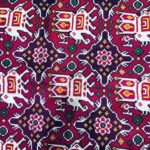Which is better, Ajrakh or Bandhini?
When you visit Gujarat, particularly Kutch, you are faced with an outstanding, even overwhelming variety of handmade crafts. Just in the realm of textiles, there is Ajrakh, Bandhini, and embroidery, to name three.
So the mind plays tricks on you. Every now and then, a foolish but inescapable question bubbles up to the top of your consciousness: which of these three crafts is better?
Well, the simple answer would be: depends on who you ask. Each of them is an example of the beauty of handmade crafts. Each of them requires the use of the hands along with the centering of the mind and the flowering of the soul or spirit. That said, each of them is different.
With Bandhini, what you see is what you get. Sure, there are painstaking techniques, particularly in tying the knots. But Bandhini at the end of the day, does not contain as many layers as Ajrakh. Since Ajrakh involves resist dyeing over several steps, a lot of the work that goes into it is hidden.
In our Ajrakh series, we attempt to open up these layers and unpack the hard work that goes behind making this beautiful blockprinted fabric.
We start with textile legend, Dr. Ismail Khatri, who, in a series of videos available on our youtube channel here, explains the processes and techniques behind the making of ajrakh.




